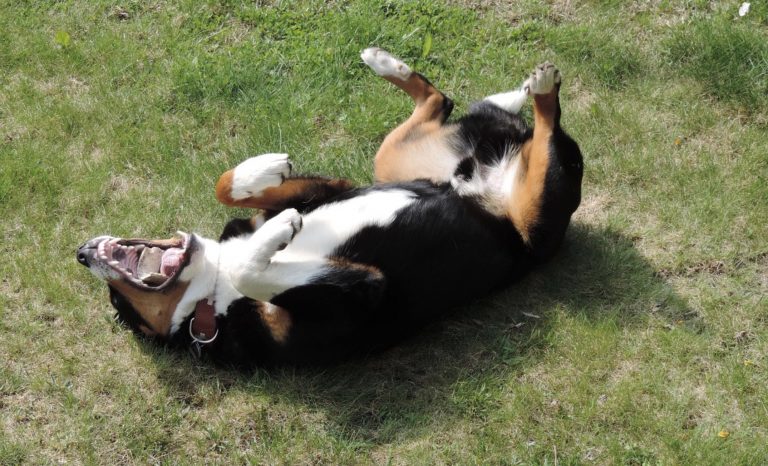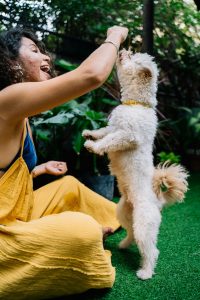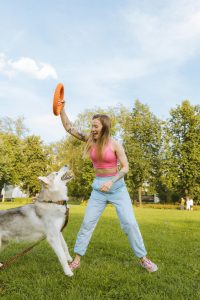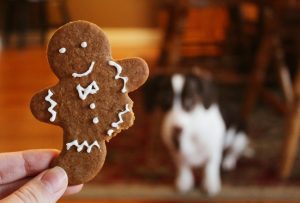Now, you might think roll over is not something your dog has to know. And you are right. It is not a basic command. Instead, the rollover trick is something you do for showing off. So, why teach dog to roll over? I have two words for you. Mental stimulation.
Learning different tricks can be stimulating for your dog. Every puppy wants to learn new things. Who doesn’t? And besides mental stimulation, a proper trick training session will improve the bond you have with your puppy.
If you are struggling to find ways to keep your dog entertained at home, learning a new trick can sound attractive.
And teaching your dog a simple command like rollover will not take you the whole day. You can do it in several minutes.
I recommend practicing the new trick for a few minutes each day, until your dog masters it.
How long does it take to teach dog to roll over?
Well, it depends on your dog. Some puppies learn a fun trick in a matter of minutes. Others need more. A Border Collie might master it in two or three tries.
Let’s say 10 minutes is the perfect amount to teach a new skill that your puppy doesn’t know before.
Understanding the basic lure reward sequence
For any dog training session, I recommend the basic training sequence. And that is the lure-reward dog training sequence.
It is quite simple, you do it in four steps. Those are request > lure > response > reward. For example, you ask your dog to do something, in this case, roll over, you lure your puppy to do it, your puppy performs, and you reward it.
Positive reinforcement is something I recommend to any dog owner for any trick. So, try it!
How to teach dog to roll over
Now let’s get over the step-by-step trick training process. For the rollover trick, here is the guide.
- Start by asking your dog to get in a down position in front of you
- You can kneel beside your dog, and hold a treat to the side of his head near the nose
- Move your hand from your dog’s nose toward its shoulder, luring your puppy to roll flat on its side
- Repeat the motion a few times, and praise and treat each time your dog follows the treat and lies flat on its side with its head on the floor
- Continue the movement of your hand, hold a treat, and once your dog is lying flat, from your dog’s shoulder to its backbone. This movement should cause your dog to roll onto its back
- Continue the moving so that your dog roll onto the other side
- When your dog is constantly following the treat all the way around in a roll over mode, you can add a verbal cue, which in this case is, roll over
- Gradually reduce the hand motion and treat lure, and try to get to a point where your dog can perform the trick with just a verbal cue
Break it down into smaller parts
I said before that not all dogs will get it. Some dogs need more time to learn a new cool trick. Or they need a different routine to learn different tricks. So, if you have a slow learner, you can break down the motion into smaller parts. Here is another way to teach dog to roll over
- Start with your dog in a down position and hold a treat at its nose. Move it toward the shoulder of your dog. When your puppy turns its head, praise it with a yes or clicker and give it a treat. Practice only this motion several times until the puppy constantly turns its head
- Next, stop giving a treat for every head turn. Give a treat only when the head turns to a point it brings it close to lying on its side
- Finally, praise and reward when your dog is lying on its side completely. See? You slowly select the behavior that comes close to rolling over, and each new behavior brings the dog closer to the end goal
- Your next goal is to get your dog onto its back, so lure it over to its other side and into a sitting or standing position. Hold the treat in front of its nose to get it done
Help your dog understand the job
I want to stress something in the end. You should not be mad at your dog for not understanding the behavior in the beginning. You cannot punish your dog for not doing something he hasn’t learned before.
If your dog is making mistakes, you may be moving ahead too quickly. You can always take a step back or two if your dog is not performing well.
Remember, some dogs might be resistant to get down on their back and show their bellies. Try to turn this into fun and games. For example, if your dog enjoys belly rubs, scratch its belly, click, praise, and give a treat when your puppy offers its belly.
Keep any trick training session short and upbeat. If the session is too long, they become frustrating for both you and your puppy. I would say 5 to 10 minutes is the most you should spend on a session.







